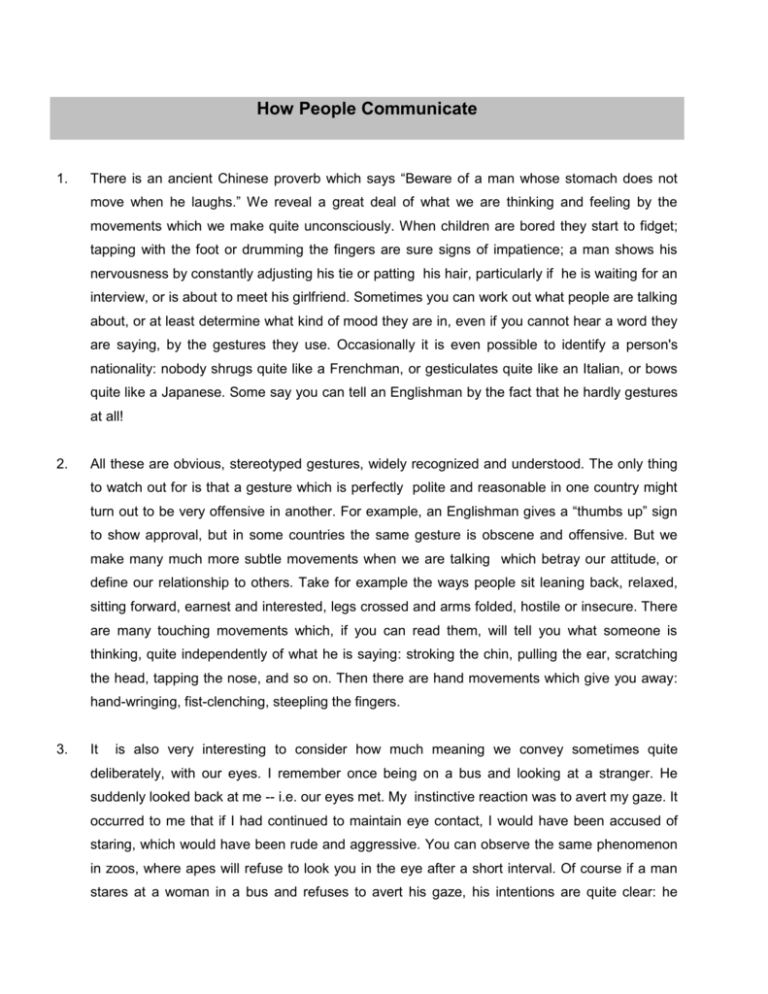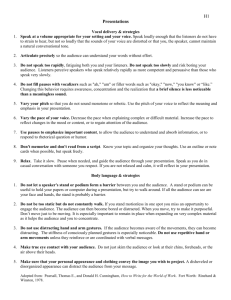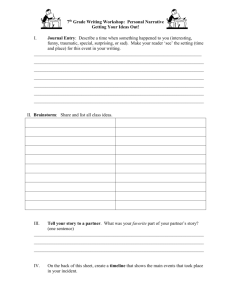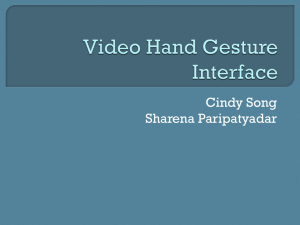Non-Verbal Communication: Gestures, Eye Contact, Body Language
advertisement

How People Communicate 1. There is an ancient Chinese proverb which says “Beware of a man whose stomach does not move when he laughs.” We reveal a great deal of what we are thinking and feeling by the movements which we make quite unconsciously. When children are bored they start to fidget; tapping with the foot or drumming the fingers are sure signs of impatience; a man shows his nervousness by constantly adjusting his tie or patting his hair, particularly if he is waiting for an interview, or is about to meet his girlfriend. Sometimes you can work out what people are talking about, or at least determine what kind of mood they are in, even if you cannot hear a word they are saying, by the gestures they use. Occasionally it is even possible to identify a person's nationality: nobody shrugs quite like a Frenchman, or gesticulates quite like an Italian, or bows quite like a Japanese. Some say you can tell an Englishman by the fact that he hardly gestures at all! 2. All these are obvious, stereotyped gestures, widely recognized and understood. The only thing to watch out for is that a gesture which is perfectly polite and reasonable in one country might turn out to be very offensive in another. For example, an Englishman gives a “thumbs up” sign to show approval, but in some countries the same gesture is obscene and offensive. But we make many much more subtle movements when we are talking which betray our attitude, or define our relationship to others. Take for example the ways people sit leaning back, relaxed, sitting forward, earnest and interested, legs crossed and arms folded, hostile or insecure. There are many touching movements which, if you can read them, will tell you what someone is thinking, quite independently of what he is saying: stroking the chin, pulling the ear, scratching the head, tapping the nose, and so on. Then there are hand movements which give you away: hand-wringing, fist-clenching, steepling the fingers. 3. It is also very interesting to consider how much meaning we convey sometimes quite deliberately, with our eyes. I remember once being on a bus and looking at a stranger. He suddenly looked back at me -- i.e. our eyes met. My instinctive reaction was to avert my gaze. It occurred to me that if I had continued to maintain eye contact, I would have been accused of staring, which would have been rude and aggressive. You can observe the same phenomenon in zoos, where apes will refuse to look you in the eye after a short interval. Of course if a man stares at a woman in a bus and refuses to avert his gaze, his intentions are quite clear: he wishes to let her know that he is admiring her. The normal pattern of eye contact when two people are engaged in conversation is that the speaker only looks at the listener from time to time, in order to assure himself that the latter is listening and grasping what is being said. The listener, on the other hand, will look more or less continuously at the speaker (except perhaps in such unnatural situations as in a car) as a sign that he is paying attention. 4. If a person looks you in the eye continuously while he is speaking to you, you are likely to be disconcerted. It is as if he were trying to dominate you. A bad liar usually gives himself away by looking too long at his victim, in the mistaken belief that to “look a man straight in the eye” is a sign of honest dealing. It may be that the opposite is true, however. In fact, continuous eye contact is usually confined to lovers, who may gaze into each other's eyes for an eternity, conveying meanings that words cannot express, and baffling onlookers into the bargain. There is even meaning to be found in how close people stand to each other and at what angle. We may stand side by side, or face to face, which is more intimate, or at some intermediate angle in between. An interesting experiment is to stand back to back with someone and try to have a conversation: it is quite unnerving not to be able to see or to establish contact with the other person, even though we have learned to have conversations with people we cannot see, as on the telephone. 5. Careful studies have been made of all these non-verbal forms of communication, and there is no doubt that what we say with words is only a part of the message we convey. It is important however, to realize that gestures, like words, tend to come in clusters, and furthermore are often capable of more than one interpretation. You must look at the whole combination of words, facial expression, gesture, and stance. If you learn to read the signs you can tell whether what a person says is what he really means, or whether, like the man whose stomach does not move when he laughs, he is trying to deceive you.











